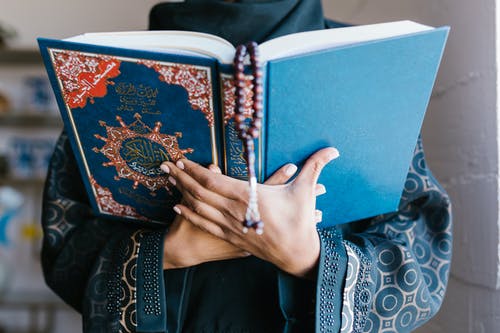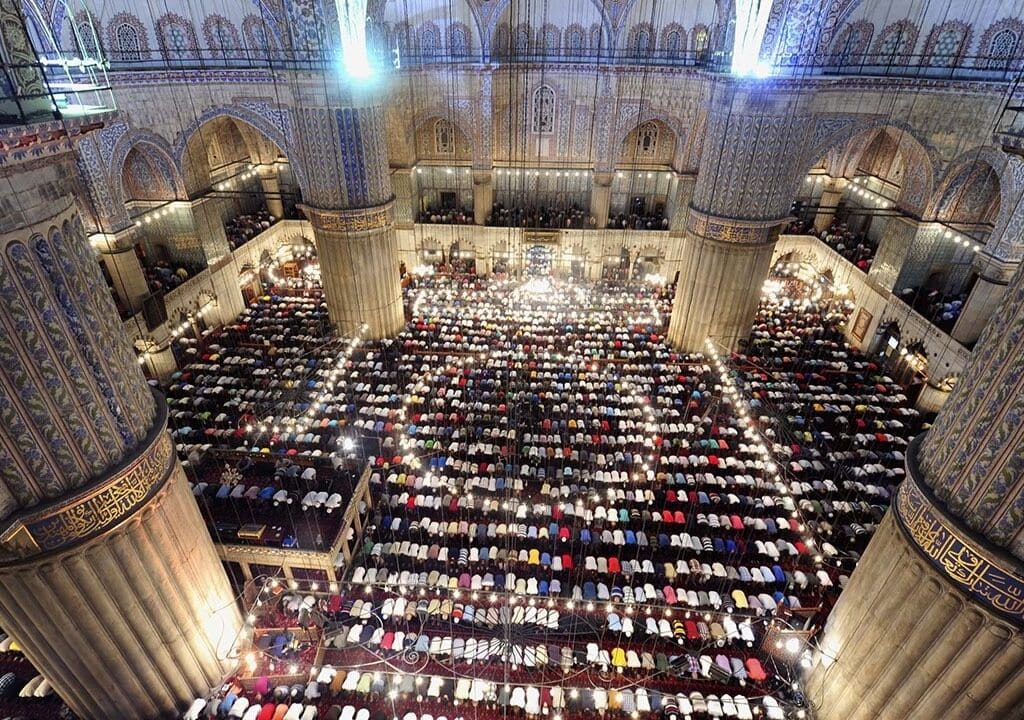In the sacred month of Ramadan, understanding “How to Pray Taraweeh” holds paramount significance. Taraweeh, a revered nightly prayer, symbolizes spiritual devotion and connection with the divine.
What is Taraweeh?
Taraweeh is a voluntary night prayer observed solely during Ramadan. As a highly recommended Sunnah, mosques worldwide conduct congregational Taraweeh prayers every night throughout this blessed month.
How many rak’at are in Taraweeh?
In Taraweeh, a rak’ah comprises standing, Quran recitation, bowing, standing again, and prostration. It’s prayed in pairs, like regular voluntary prayers.
Traditionally, Taraweeh consists of either 8 or 20 rak’at. Most mosques observe 20 rak’at led by the imam, supported by all four schools of thought.
The term ‘Taraweeh’ stems from the Arabic word for rest, indicating breaks after every four rak’at. This allows worshippers to rejuvenate during the prayer session.
When do we pray Taraweeh?
Taraweeh is performed at night, following the obligatory ’Isha prayer. It’s essential not to pray Taraweeh after the Witr prayer, as Witr marks the night’s final prayer.
Ensuring Taraweeh is completed before Fajr begins is crucial. It’s permissible to sleep after ’Isha and awaken later in the night for Taraweeh, which holds immense rewards.
Prophet Muhammad (peace be upon him) stated, “Our Lord Almighty descends to the lowest heaven in the last third of every night, saying, ‘Who is calling upon Me that I may answer him? Who is asking from Me that I may give him? Who is seeking My forgiveness that I may forgive him?'” [Bukhari]
Can we pray Taraweeh at home?
Yes, you can pray Taraweeh at home. Whether in congregation with family or alone, it’s permissible. Prophet Muhammad (peace be upon him) himself prayed Taraweeh at home, as narrated by Aishah (may Allah be pleased with her).
Can we hold a Qur’an while praying?
In the Hanbali, Maliki, and Shafi’i schools, holding a Qur’an during voluntary prayers, including Taraweeh, is permissible, even for the imam. This applies to digital copies as well. However, in the Shafi’i school, movement should be minimal to avoid invalidating the prayer.
Within the Hanafi school, opinions vary. Some scholars deem holding the Qur’an impermissible during prayer, while others permit it but consider it disliked.

Guidance for Women: Praying at Home vs. the Mosque
For women, it’s preferable to pray at home rather than in the mosque, whether it’s an obligatory or voluntary prayer, including Taraweeh. The scholars highlight this preference, stating that a woman’s prayer in her own house holds greater virtue than praying in the mosque, as per the Fatwa of the Standing Committee.
Can a woman lead taraweeh prayer at home?
Yes, if there are multiple women in the household, it’s permissible for one of them to lead the others in congregational prayer, including Taraweeh. The woman leading should stand in the middle of the row and recite to the best of her ability. Additionally, it’s acceptable for her to recite from the Mus-haf (Qur’an).
Shaykh Ibn ‘Uthaymin (may Allah have mercy on him) said:
“It is better for a woman to pray in her house, even if there is a mosque in which Taraweeh prayers are held, and if she prays in her house, there is nothing wrong with her leading other women in the house in prayer. In this case, if she has only memorized a little of the Quran, she may read from the Mus-haf .” (Fatawa Nur ‘ala ad-Darb by Ibn ‘Uthaymin)
Which du’a to recite for taraweeh?
There isn’t a specific du’a designated for Tarawih prayers. Worshippers are free to make any supplications they choose during or after Tarawih. This includes reciting du’as from the Qur’an and Sunnah, as well as personal supplications.
During breaks between every four rak‘at (two two-unit prayers), some worshippers recite words of remembrance, which may be displayed in the mosque. These typically include phrases praising Allah’s attributes and seeking refuge from Hellfire.
سُبْحانَ ذِي الْمُلْكِ وَالْمَلَكُوتِ سُبْحانَ ذِي الْعِزَّةِ وَالْعَظْمَةِ وَالْهَيْبَةِ وَالْقُدْرَةِ وَالْكِبْرِياءِ وَالْجَبَرُوْتِ
سُبْحانَ الْمَلِكِ الْحَيِّ الَّذِيْ لا يَنامُ وَلا يَمُوتُ. سُبُّوْحٌ قُدُّوْسٌ رَبُّنا وَرَبُّ المْلائِكَةِ وَالرُّوْحِ
اللَّهُمَّ أَجِرْنا مِنَ النّارِ يا مُجيرُ يا مُجيرُ يا مُجيرُ
Exalted is the Possessor of the hidden and the manifest dominion. Oh Allah, Exalted is the Possessor of Might, Greatness, Reverence, Power, Pride, and Majesty. Exalted is the Master, the Living, the one who neither sleeps nor dies. All perfect, All holy, Our Lord and the Lord of the angels and the soul. O Allah, grant us refuge from the Hellfire, O Granter of refuge, O Granter of refuge, O Granter of refuge.
Reward for Tarweeh prayer
The foremost reward of praying Tarawih is profound. Prophet Muhammad (peace be upon him) declared, “Whoever stands for prayer (the night prayer) during Ramadan with faith, anticipating rewards, will find all their past sins forgiven.” [Bukhari]
Moreover, observing Tarawih entails adhering to the Sunnah, along with the special Ramadan privilege of multiplied rewards.

How to pray Taraweeh Step by Step?
1-Wuddu:
Before praying Tarawih, make sure you have performed ablution (wudu) and are dressed modestly. For men, this means clothing that covers from the navel to the knees. Women should cover everything except their hands, feet, and face.
2-Standing (Qiyam):
Standing (Qiyam) during prayer is obligatory according to the Quran (Surah al-Baqarah, verse 238) and numerous authentic hadiths (Sahih Bukhari: 6667). The Quranic verse states: “Guard strictly your prayers, especially the middle prayer, and stand before Allah in devoutness.” This emphasizes the importance of standing in prayer as an act of devotion to Allah. For those physically capable of standing, it is considered a pillar (essential element) of Salah. However, if someone is unable to stand due to physical disability or any other reason, they are allowed to pray in a seated position. If sitting is not possible, they may pray while lying down on their side or in any other position that allows them to fulfill the prayer. This allowance is also supported by various authentic hadiths (Sahih Bukhari: 1117).
3-Intension (an-Niyah):
The intention (an-Niyah) for prayer plays a crucial role because it indicates understanding and awareness of the specific prayer being performed, such as Zuhr, Asr, etc. Merely saying Allahu Akbar and beginning prayer without intention invalidates it. Sahih al-Bukhari narrates, “The reward of deeds depends upon the intention and every person will get the reward according to what he has intended.” (Sahih al-Bukhari 1) It’s important to note that neither the Prophet (peace be upon him) nor his Companions instructed audibly or inaudibly stating intentions for acts of worship. Therefore, one should silently make the intention (Niyyah) for prayer in the heart.
4-Opening Takbeer- saying Allahu akbar:
The Takbeer-e-Tehrima, or the opening Takbeer, marks the beginning of the prayer. As narrated in Sahih Bukhari 6251, it involves raising both hands up to the level of the shoulders or ears while saying “Allahu Akbar” (Allah is the Greatest). The hands are then folded over the chest, with the right hand placed over the left hand.This practice is further confirmed by various hadiths, including Sahih Bukhari 740, Sahih Muslim 401, Ibn Khuzaimah 1/243, and Abu Dawood 726 and 759. Narrations such as those of Sahl bin Sa`d and Wa’il b. Hujr describe the positioning of the hands during prayer, emphasizing the Prophet’s method of placing the right hand over the left on the chest.
5-Looking at the Place of Prostration:
When praying, it is important to maintain focus and avoid distractions. The Prophet Muhammad (peace be upon him) instructed believers to direct their gaze towards the place of prostration, without looking to the right or left. This guidance aims to enhance attentiveness and devotion during prayer. As narrated in Sahih Bukhari 3291, `Aisha (may Allah be pleased with her) asked the Prophet (peace be upon him) about looking around during prayer, to which he responded that such actions allow Satan to steal from one’s prayer.
Additionally,
in Sahih Bukhari 750, Anas bin Malik reported the Prophet’s stern warning against looking towards the sky during prayer, emphasizing the importance of focusing on the place of prostration. He cautioned that failing to do so could lead to the loss of eyesight. Therefore, to maintain concentration and reverence in prayer, one should keep one’s gaze fixed on the place of prostration, as directed by the teachings of the Prophet Muhammad (peace be upon him).
6-Dua of Istiftah (Opening Dua):
After assuming the standing position and directing our gaze towards the place of prostration, it is customary to recite the opening supplication, known as the Dua of Istiftah. One of the most commonly recited versions of this supplication is:”Subḥānaka Allāhumma wa bi-ḥamdika wa tabāraka-smuka wa taʿālā jadduka wa lā ilāha ghayruk.” This translates to:
سُبْحَانَكَ اللّٰهُمَّ وَبِحَمْدِكَ ، وَتَبَارَكَ اسْمُكَ ، وَتَعَالَىٰ جَدُّكَ ، وَلاَ إِلٰهَ غَيْرُكَ
“How Perfect are You, O Allah, and all praise is Yours. Your Name is most blessed, Your majesty is exalted, and there is no god worthy of worship except You.” (Tirmidhi 243)
Reciting this dua helps to initiate the prayer with humility, gratitude, and recognition of Allah’s greatness and uniqueness.
7-Istizah:
After reciting the opening supplication (dua of Istiftah), it is recommended to recite the Taawudh. There are various versions of this supplication, including:
أَعُوذُ بِاللَّهِ مِنَ الشَّيْطانِ الرَّجِيْمِ
“I seek refuge in Allah from the rejected Satan.”
or
أَعُوذُ بِاللَّهِ السَّمِيعِ الْعَلِيمِ مِنَ الشَّيْطَانِ الرَّجِيمِ مِنْ هَمْزِهِ وَنَفْخِهِ وَنَفْثِهِ
“I seek refuge in Allah, the All-Hearing, the All-Knowing, from the cursed Satan, from his madness, his arrogance, and his poetry.”
This practice is confirmed by a narration from Abu Sa’eed Al Khudri, wherein Prophet Muhammad (peace be upon him) recited the Taawudh after the dua of Istiftah. (Jami` at-Tirmidhi 242)
8-Basmallah:
After reciting the Taawudh silently, you should recite the Tasmiyah silently as well:
بِسْمِ ٱللَّهِ ٱلرَّحْمَٰنِ ٱلرَّحِيمِ
“In the Name of Allah, the Most Gracious, the Most Merciful.”
This practice is confirmed by a narration from Anas, who stated that he prayed with the Prophet Muhammad (peace be upon him), Abu Bakr, Umar, and Uthman (may Allah be pleased with them all), but he never heard any of them reciting Bismillah-ir-Rahman-ir-Rahim loudly. (Sahih Muslim 399a) Therefore, the recitation of both the Taawudh and the Tasmiyah should be done silently, within one’s heart.
9-Recite Surah Al Fatiha and any other Surah:
After reciting the Taawudh and Tasmiyah silently, you should recite Surah Al-Fatiha. It is considered the pillar of Salah (prayer), and without reciting it, the prayer would be invalid. The English translation of Surah Al-Fatiha is as follows:
“In the name of Allah, the Extremely Merciful, the Especially Merciful. All praises and thanks are for Allah, The Extremely Merciful, The Especially Merciful, Master of the Day of Judgement. You Alone we worship, You Alone we ask for help. Guide us on the Straight Path, the path of those whom You have favoured, not of those who incur (Your) anger nor of those who have gone astray.” (Quran 1:1-7)
This obligation is confirmed by a narration from ‘Ubada bin As-Samit, where the Prophet Muhammad (peace be upon him) stated, “Whoever does not recite Al-Fatiha in his prayer, his prayer is invalid.” (Sahih al-Bukhari 756)
After reciting Surah Al-Fatiha, it is recommended to recite any other Surah from the Quran. The minimum requirement is to recite three verses, or one long verse that is equivalent in length to three short verses. However, it is preferable to recite a complete Surah.
10- Rukoo:
After reciting the Quranic verses, the person offering prayer should raise their hands in the manner described previously for the initial Takbeer (known as Raful-yadain) and also say the Takbeer (i.e., “Allahu Akbar”) while moving.
Then, the person will perform the Rukoo (bowing) in such a manner that all their joints are settled, and each part of the body is at rest. This is considered a pillar of Salah.
The Sunnah way of performing Rukoo involves placing the hands firmly upon the knees, spreading the fingers as if grasping the knees, and stretching out the back to make it level. The head should neither droop lower than the back nor be raised above it; rather, it should be kept level. The elbows should be kept straight and apart from the sides. During Rukoo, the person should say, three times or more:
“Subhaana Rabbiyal-‘Adheem” which means “Glory to my Lord the Exalted.”
These practices are based on the teachings of the Prophet Muhammad (peace be upon him) as narrated in various authentic hadiths.
11- Straightening Up from the Rukoo:
After completing the Rukoo (bowing), the person must raise up and straighten their back, transitioning to the standing position known as Qawmah in Arabic. While rising, the person should say:
“Sami’ Allaahu liman hamidah” which means “Allah heard those who sent praises to Him.” (Sahih Bukhari: 795)
The person should raise their hands when rising, as narrated in Sahih Muslim 390, in the manner described previously for Takbeer-e-Tehrima. Then, the person should stand straight up and remain still, ensuring that every bone returns to its place. While standing, they should say:
“Rabbanaa wa lakal-hamd” which means “O our Lord! And all praise is for You.” (Sahih Bukhari: 795)
This practice is obligatory for everyone performing the prayer, even if they are praying behind an Imam. Various other supplications can be recited in Arabic during this transition, as mentioned in Sahih Bukhari 789, Sahih Muslim 415, and Sahih Bukhari 795.
12- First Prostration (Sajda):
After Qawmah, move to perform the first Sajdah.
Conditions of Prostration:
The Prophet Muhammad (peace be upon him) stated that he has been ordered to prostrate on seven bones: the forehead along with the tip of the nose, both hands, both knees, and the toes of both feet. It’s important not to gather clothes or hair during prostration. (Sahih Bukhari 812)
Way of Prostration:
During prostration, the forehead and nose should touch the surface of the place of prayer. The fingers of the hands should face towards the direction of the Qiblah. Palms can be placed next to the shoulders or slightly closer to the ears. Knees should not be too close, and toes should face towards the Qiblah. Arms should be wide and spread, not touching the body, and the stomach should not touch the thighs. The feet should not dangle. (Abu Dawood 732, Sahih Muslim 401, Sahih Bukhari 828, Sahih Bukhari 390, Abu Dawood 735)
During prostration, the person should say “Allah-u-Akbar” while going into prostration. While in the prostration position, they should say, at least three times: “Subhaana Rabbiyal-Alaa” which means “Glory is to my Lord, the Most High.” (Abu Dawud: 857)
After completing the first prostration calmly and perfectly, the person should raise their head from prostration, saying “Allah-u-Akbar,” and then sit on their left foot while keeping the right foot propped up with its toes pointing towards the Qiblah. The palms of the hands should rest on the thighs and knees, with the back straight so that the joints go back in place. (Sunan An Nasai 1159)
It’s important to sit as straight as possible during the two prostrations as the prayer is not valid if the backbone is not brought to rest while bowing and prostrating. (An-Nasai: 1027)
Sitting between two prostrations (Jalsah):
Between two prostrations, the person should say, at least once: “Rabbighfir li, Rabbighfir li” which means “O Lord forgive me, O Lord forgive me.” (Sunan Ibn Majah 897)
13-Second Prostration (Sajdah):-
After sitting, proceed to the second prostration by saying “Allah-u-Akbar”. They should then repeat the same actions and supplications performed during the first prostration. Place forehead and nose on ground, fingers facing Qiblah, and recite “Subhaana Rabbiyal-Alaa” at least three times. The second prostration should be performed with the same level of calmness and perfection as the first one.
14-Second Rakaat (2nd unit of prayer) :-
After standing up for the second unit of prayer (Rakaat), the person should fold their hands over their chest, as done in the first Rakaat, and begin the recitation by saying “Bismillah ir-Rahman ir-Rahim” (In the name of Allah, the Most Gracious, the Most Merciful), followed by reciting Surah Al-Fatiha and then any other Surah or verse from the Holy Quran. They should then complete the second Rakaat in the same manner as the first one.
15-Tashahud:
After completing the second rak’ah of the prayer, the person sits to perform the Tashahud. They should sit upon their left foot, keeping it flat on the ground, as previously mentioned for the sitting between the two prostrations. However, one must not sit on both heels during this sitting, nor should one sit while resting upon the hand, especially the left hand (unless due to discomfort or injury).
Reference:
Abu Humaid As-Saidi (R.A.) said: “I remember the prayer of the Messenger of Allah (S.A.W.) better than anyone of you…. When sitting in the second rak’ah, he (S.A.W.) sat on his left foot and propped up the right one; and in the last rak’ah, he pushed his left foot forward and kept the other foot propped up and sat over the buttocks.” (Sahih Bukhari: 828)
The person should clench all the fingers of their right hand, placing the thumb onto the middle finger. Alternatively, they may form a circle with their thumb and middle finger together. They should then raise their index finger and move it up and down while supplicating, pointing it towards the Qiblah (Direction of Prayer) and focusing their gaze upon it. It’s a Sunnah act to observe the movement of the forefinger during the Tashahud.
Reference:
Wa’il bin Hujr said: “I am going to watch the Messenger of Allah (ﷺ) and see how he prays. So, I watched him.” And he described (his prayer): “Then he sat and laid his left foot on the ground and placed his left hand on his left thigh and knee. He put his right elbow on his right thigh, then he made a circle with two fingers of his (right) hand, then he raised his finger and I saw him moving it, supplicating with it.” (Sunan an-Nasa’i 1268 &1160&890, Sahih Muslim 580b, Abu Dawood 726)
After completing the second rak’ah, the person recites the following supplication:
“All greetings of humility are for Allah, and all prayers and goodness. Peace be upon you, O Prophet, and the mercy of Allah and His blessings. Peace be upon us and upon the righteous slaves of Allah. I bear witness that there is none worthy of worship but Allah, and I bear witness that Muhammad is His slave and His Messenger.” (Sahih Bukhari 7381)
Following this, the person sends blessings upon Prophet Muhammad (peace be upon him) by reciting:
“O Allah, bestow Your favor on Muhammad and on the family of Muhammad as You have bestowed Your favor on Ibrahim and on the family of Ibrahim, You are Praiseworthy, Most Glorious. O Allah, bless Muhammad and the family of Muhammad as You have blessed Ibrahim and the family of Ibrahim, You are Praiseworthy, Most Glorious.” (Sahih Bukhari 3370)
التَّحِيَّاتُ للهِ، وَالصَّلَوَاتُ، وَالطَّيِّبَاتُ،السَّلَامُ عَلَيْكَ أَيُّهَا النَّبِيُّ وَرَحْمَةُ اللهِ وَبَرَكَاتُهُ، السَّلَامُعَلَيْنَا وَعَلَى عِبَادِ اللهِ الصَّالِحِينَ. أّشَْدُ أَنْ لَا إِلَهَ إِلَّا اللهُوَأَشْهَدُ أَنَّ مُحَمَّداً عَبْدُهُ وَرَسُولُهُ
اللَّهُمَّ صَلِّ عَلَى مُحَمَّدٍ وَعَلَى آلِ مُحَمَّدٍكَمَا صَلَّيْتَ عَلَى إِبْرَاهِيمَ وَعَلَى آلِ إِبْرَاهِيمَ، إِنَّكَ حَمِيدٌ مَجِيدٌ،اللَّهُمَّ بَارِكَ عَلَى مُحَمَّدٍ وَعَلَى آلِ مُحَمَّدٍ كَمَا بَارَكْتَ عَلَى إِبْرَاهِيمَوَعَلَى آلِ إِبْرَاهِيمَ، إِنَّكَ حَمِيدٌ مَجِيدٌ
Afterward, in this Tashahud, the person may choose any of the reported supplications and supplicate to Allah with it.
16-The Salutation (Tasleem) (Ending The Prayer):
After completing the ‘Final Tashahud’, the person should give salutations to their right side, turning their face so that the whiteness of their right cheek can be seen, by saying:
“Peace and blessings of Allah be unto you.”
Then, they will give salutations to their left side, turning their face so that the whiteness of their left cheek can be seen, by saying:
“Peace and blessings of Allah be unto you.”
Reference:
It was narrated from Abdullah (R.A.) that: “The Prophet (S.A.W.) used to say salam (Taslim) to his right and to his left: ‘Peace be upon you and the mercy of Allah, peace be upon you and the mercy of Allah’ until the whiteness of his cheek could be seen from here, and the whiteness of his cheek from here. (An-Nasai: 1324)


